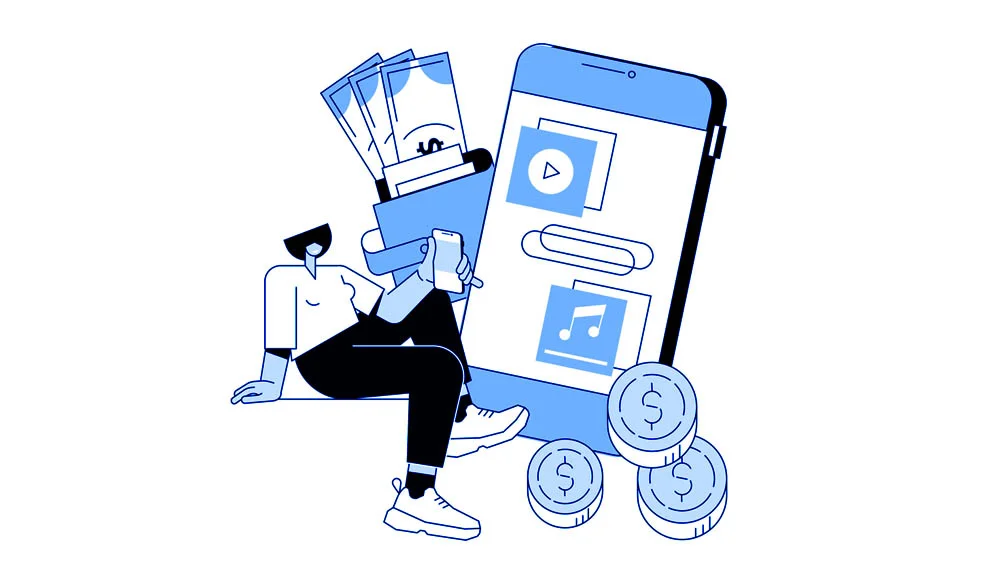Want to break your eight-hour working-shift routine? I sure want to. If that is the case and you are aspiring to be the ultimate appreneur (an app-related entrepreneur), read this guide on passive income app development. That is in order to understand all about how to create and develop an app that supports passive income. Passive income is a popular goal for many people, and app development can be a great way to achieve it.
Since so many people use smartphones and tablets every day, there is a huge market for creative apps that provide functionality for solving issues, having fun, or simply improving one’s life. The mobile app market offers developers and business-minded people an unrivaled opportunity to create a passive revenue stream through app creation.
This comprehensive guide covers everything you need to know to create a successful passive income stream through app development, including choosing a niche, developing your app, and marketing it effectively.
Understand the Basics of Passive Income
A passive income is a constant stream of money that takes very little effort, if any effort at all, on an ongoing basis. The objective is to generate a consistent flow of cash without having to commit oneself to full-time employment on a daily basis (fun, right?) This type of income can come from a variety of sources, such as returns on investments, income from real estate properties, royalties from a YouTube video, and other similar sources.
Passive income acts as a reliable supporter who is never far away. It comes from activities like investing and renting out real estate that require little to no upkeep. As a result, after creating a passive income stream, you can start making money without actually working for it. However, it’s important to note that while some things need a lot of work to start (like making a YouTube video), the work required to keep them going is usually very little. However, both types (referring to active income as well) are equally crucial. It is advisable to strive for both active and passive income.
Passive Income and App Development: A Quick Overview
Before diving into app development for passive income, it’s important to understand the basics of both concepts. Like we mentioned above, passive income refers to income that is earned without actively working for it, such as through investments or rental properties. App development involves creating software applications for mobile devices that can be sold or monetized through advertising. By combining these two concepts, you can create a passive income stream through app development.
Identify a Profitable Niche and Conduct Market Research
This is one of the very first steps that must be taken in order to succeed. A thorough market study will help you identify what is a profitable niche and what isn’t. We emphasize how important this step is because creating a successful passive income stream through app development requires identifying a profitable niche and conducting thorough market research. This involves researching popular app categories, analyzing user demographics and behavior, and identifying gaps in the market that your app can fill. By understanding your target audience and their needs, you can create an app that is both useful and profitable.
You will be able to make money from this app as it solves a certain market problem that lacks solutions. That is why it is crucial that you stay updated with what the market has to offer, including new or potential problems, to be able to provide the right service that solves these problems. Additionally, conducting market research can help you determine the best pricing strategy and monetization model for your app.
Develop a Unique Value Proposition For Your App
After you have found a lucrative market segment, come up with concepts for an app that addresses a need or enhances an already successful product. This method could involve conducting market research, surveying potential customers, and examining competing apps to identify areas that require improvement. The key is to develop a unique and creative concept that appeals to your target market and sets your app apart from similar ones on the market.
Choose the Right Platform and Development Tools
Once you have identified your niche and conducted market research, it’s time to choose the right platform and development tools for your app. This step is easier said than done. That is because there are several options available, including iOS, Android, and cross-platform development tools like React Native and Xamarin. Each platform has its own advantages and disadvantages, so it’s important to consider factors like target audience, budget, and development timeline when making your decision. Additionally, you will need to choose the right development tools, such as programming languages, frameworks, and libraries, to ensure that your app is functional and user-friendly.
You can simply avoid all of that if you don’t want to opt for the traditional “hire a developer” option if you aren’t one yourself. You can conduct thorough research on no-code app builders. These app builders allow you to develop and create an app from scratch using a simple drag-and-drop interface. If you have no prior coding or programming language knowledge, the no-code app builder solution is the perfect choice that you should opt for.
Create a User-Friendly and Engaging App
Creating a user-friendly and engaging app is crucial to its success and generating passive income. This means designing an intuitive user interface, providing clear instructions and feedback, and incorporating features that keep users coming back. Consider adding features that might appeal to your users. For example, push notifications, social media integration, and in-app purchases. This will help you enhance the user experience and increase revenue. Additionally, regularly updating and improving your app based on user feedback can help maintain its popularity and profitability. This way, you will have an app with top-notch features that will gain popularity and increase your download rates. Consider enabling ads in your app for better profits through integrations.
Test Your App Before Releasing or Publishing It
It is essential to test your app’s functionality and fix any bugs or issues before publishing it. To provide a seamless user experience, conduct thorough testing on a variety of hardware and operating systems. Ask your friends, family, or beta testers for their opinions on the functionality and usability of your program. Based on this feedback, make any adjustments that are required.
Monetize Your App and Optimize for Success
Once you have developed your app, it’s time to start generating revenue. There are several ways to monetize your app, including in-app advertising, in-app purchases, and subscription models. It’s critical to pick a monetization approach that complements the goals and target market of your app. Additionally, optimizing your app for success involves regularly analyzing user data and making improvements based on that data. This includes monitoring user engagement, retention rates, and revenue streams to identify areas for improvement and growth.
Analyze and Optimize Your App
Use analytical tools like Google Analytics for Mobile or Flurry to track user behavior and app effectiveness after your app is made available. Use this data to identify areas that require improvement and optimization. Update your program frequently to fix bugs, add fresh features, and improve the user experience. Respond to user comments and criticisms to show that you value their feedback and are committed to producing top-notch app software.
Quick Tips and Tricks for Passive Income App Development
Because we value the effort you will put into a passive income app development process, here are some quick tips and tricks for you to follow:
- Avoid Google Play until your app is on demand: “Why?” Let me answer that briefly. The market and user base of Google Play are distinct from those of Apple. This means that while your software might be doing fantastic on iOS, it might not get as much momentum and garner quite different reviews on Google Play. No one should take any of this advice as gospel, but in my experience, even when you provide Google Play customers with the exact same software as the iOS version, they don’t like it as much and are more likely to be critical that it might not be adding something new to their mobile devices. For novices, I normally advise waiting until you have multiplied your initial investment in Apple development by five.
- Keep your app’s designs simple: This tip is common and speaks for itself. Nevertheless, your app should stay simple for multiple reasons. Be careful to start with the most important features first, because adding more features will cost money and may cause your app to be slow or hard to navigate. If there is still demand from your audience for certain features, add them. In fact, you might think about making it an in-app purchase!
- Add the right features that the market’s competition lacks: One of the simplest ways to achieve this is to add or correct the features that customers have suggested for your competitors’ apps in app reviews through Google’s Play Store or Apple’s App Store.
Wrapping It up for You
No-code native app builders would be the solution we would nag you to opt for. They are simple and cheap (some are average or expensive), but the majority are fine. You can develop an app yourself using coding and programming languages, or you can go for the easier and equally efficient option. nandbox is currently the only native no-code app builder on the market. We help you create native applications from scratch without having any prior knowledge of coding or programming languages. You will simply drag and drop your desired features into your app window after choosing the pre-made template that you wish to customize.
Sign up now for nandbox’s native no-code app builder and develop a passive income app that will help you strengthen yourself with a new income strategy. Enjoy our 7-day trial that is activated upon signing up. This trial simply helps you familiarize yourself with the whole app building process and how to navigate the app builder itself.






